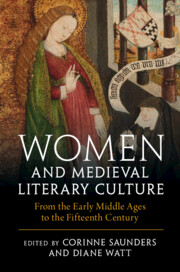Book contents
- Women and Medieval Literary Culture
- Women and Medieval Literary Culture
- Copyright page
- Contents
- Illustrations
- Contributors
- Acknowledgements
- Introduction
- I Patrons, Owners, Writers, and Readers in England and Europe
- Chapter 1 ‘Miserere, meidens’
- Chapter 2 Creating Her Own Story
- Chapter 3 Woman-to-Woman Initiatives Between English Female Religious
- II Circles and Communities in England
- III Health, Conduct, and Knowledge
- IV Genre and Gender
- V Women as Authors
- General Index
- Index of Manuscripts
- References
Chapter 1 - ‘Miserere, meidens’
Abbesses and Nuns
from I - Patrons, Owners, Writers, and Readers in England and Europe
Published online by Cambridge University Press: 28 July 2023
- Women and Medieval Literary Culture
- Women and Medieval Literary Culture
- Copyright page
- Contents
- Illustrations
- Contributors
- Acknowledgements
- Introduction
- I Patrons, Owners, Writers, and Readers in England and Europe
- Chapter 1 ‘Miserere, meidens’
- Chapter 2 Creating Her Own Story
- Chapter 3 Woman-to-Woman Initiatives Between English Female Religious
- II Circles and Communities in England
- III Health, Conduct, and Knowledge
- IV Genre and Gender
- V Women as Authors
- General Index
- Index of Manuscripts
- References
Summary
This study of medieval nuns and abbesses as scribes focuses on manuscript evidence from post-Conquest England, especially in relation to changing institutional ownership. Looking initially at an early-twelfth-century legal manuscript from St Paulߣs London (Cambridge, Corpus Christi College, MS 383), the essay draws our attention to short texts that were subsequently added to it by one ߢMatildaߣ for the benefit of a female audience. Similar additions are made to another manuscript (London, British Library, Cotton MS Vespasian D. xiv) which contains homilies and saintsߣ lives, this time by an ߢancillaߣ or nun, who inserted prayers that she had authored herself sometime in the late twelfth century. These findings are important because there is very little proof of womenߣs scribal activity in medieval England: hitherto scholars have assumed that manuscripts are written and glossed by men.
Keywords
- Type
- Chapter
- Information
- Women and Medieval Literary CultureFrom the Early Middle Ages to the Fifteenth Century, pp. 27 - 49Publisher: Cambridge University PressPrint publication year: 2023
References
Further Reading
- 1
- Cited by



